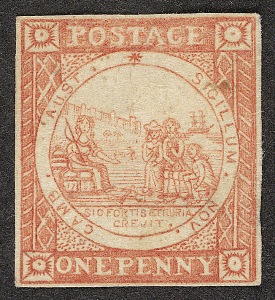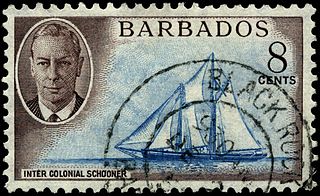
This is a survey of the postage stamps and postal history of South Australia , a former British colony that is now part of Australia.

This is a survey of the postage stamps and postal history of South Australia , a former British colony that is now part of Australia.

The first postmaster of South Australia was Thomas Gilbert, appointed in 1836. Letters sent or received were charged one penny. [1] The first Post Office Act of 1839 established rates of 3 or 6 pence for letters delivered within the colony. By 1840 there were six post offices.
In July 1841 a rate based on weight and distance was implemented. The rate for letters received from places other than the other Australian colonies was set at 8 pence up to half an ounce, 1/- for up to one ounce, 1/3d for up to 1½ ounces, and 1/6d for letters up to 2 ounces. All letters or packages above 2 ounces were to be charged 2/6d. For letters to or from the other Australian colonies the rate was 6d for up to one ounce (9d, 1/-, 1/3d then 2/6 for higher weights as above). [2]

The first stamp of South Australia was issued on 1 January 1855. [3] [4] The arrangements for the first issue of stamps had been made by the postmaster John Cliffe Watts in 1854. Perkins Bacon was commissioned to design and produce a two pence design for the colony. The design incorporated parts of the first issue of Chile with the sideface portrait of Queen Victoria as used in the New South Wales design. Corner designs and the value tablet were similar to the British issue. William Humphreys was the engraver. A plate of 240 impressions was used in 20 rows of 12. [5]
The TWO PENCE value was printed in carmine-red and was put on sale to the public on 1 January 1855. Orders for three more values were placed with Perkins Bacon – ONE PENCE, SIX PENCE and ONE SHILLING values. The ONE PENNY and SIX PENCE stamps were placed on sale in the colony on 26 October 1855, however, the ONE SHILLING value was found to be an unsuitable colour when it arrived in the colony being too close in colour to the blue SIX PENCE value and almost all of the printed 500,000 sheets were burnt. [5]
In 1913 the stamps of South Australia were superseded by those of Australia.

The Penny Black was the world's first adhesive postage stamp used in a public postal system. It was first issued in the United Kingdom on 1 May 1840 but was not valid for use until 6 May. The stamp features a profile of Queen Victoria.

The postal and philatelic history of Canada concerns postage of the territories which have formed Canada. Before Canadian confederation, the colonies of British Columbia and Vancouver Island, Prince Edward Island, Nova Scotia, New Brunswick and Newfoundland issued stamps in their own names. The postal history falls into four major periods: French control (1604–1763), British control (1763–1841), colonial government control (1841–1867), and Canada, since 1867.

The Penny Red was a British postage stamp, issued in 1841. It succeeded the Penny Black and continued as the main type of postage stamp in the United Kingdom of Great Britain and Ireland until 1879, with only minor changes to the design during that time. The colour was changed from black to red because of difficulty in seeing a cancellation mark on the Penny Black; a black cancellation mark was readily visible on a Penny Red.

Postage stamps and postal history of Great Britain surveys postal history from the United Kingdom and the postage stamps issued by that country and its various historical territories until the present day.

This is a survey of the postage stamps and postal history of the Falkland Islands.

The adhesive embossed postage stamps of the United Kingdom, issued during the reign of Queen Victoria between 1847 and 1854 exhibit four features which are unique to this issue:

This is an overview of the postage stamps and postal history of Australia.

This is a survey of the postage stamps and postal history of New South Wales, a former British colony now part of Australia.

The Two Penny Blue or The Two Pence Blue was the world's second official postage stamp, produced in the United Kingdom of Great Britain and Ireland and issued after the Penny Black.

The postal history of the Bahamas begins in the 18th century, with the first post office operating since 1733. The earliest known letters date from 1802. In 1804 a straight-line "BAHAMAS" handstamp came into use. The Royal Mail Line initiated a regular mail service in 1841, and from 1846 used a "Crown Paid" handstamp along with a dated postmark for New Providence.

The Chalon Head is the name of a number of postage stamp series whose illustration was inspired by a portrait of Queen Victoria by Alfred Edward Chalon (1780–1860).

This is a survey of the postage stamps and postal history of Jamaica.

The postage stamps and postal history of Norfolk Island depended on Australia until 1947, when the island, an Australian territory since 1914, received its own stamps and postal autonomy.
Antigua was discovered by Christopher Columbus, in 1493, and was named after the church of Santa Maria la Antigua in Seville. It was first settled in 1632. By the Treaty of Breda in 1667 it became a British Possession.

This is a survey of the postage stamps and postal history of Barbados.

This is a survey of the postage stamps and postal history of Cape of Good Hope.

St. Lucia a former British dependency in the Windward Islands began using stamps in 1860. It achieved Associated Statehood on 1 March 1967. In 1979, it gained independence.

Western Australia, a state of Australia and formerly a British colony, established its postal service soon after the British settled in 1829; in December of that year, Fremantle's harbourmaster was appointed postmaster. A post office in Albany opened on 14 October 1834, and the main post office moved to Perth in 1835.

The Black Swan is the first postage stamp issued by the British colony of Western Australia in 1854. It illustrates a black swan, a typical Australian animal at the time and was the only image used on Western Australian stamps until 1902.